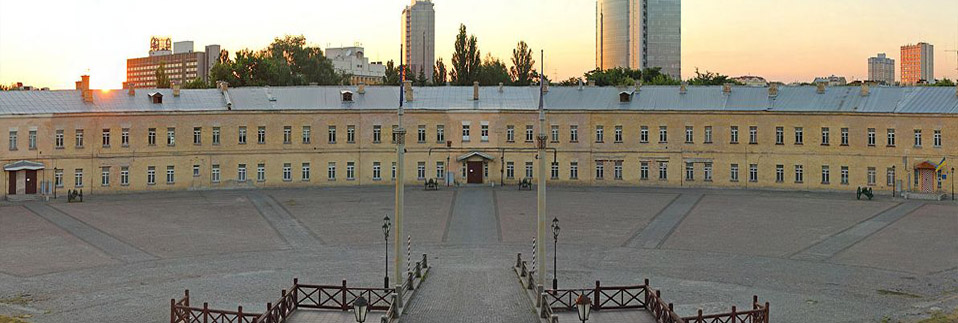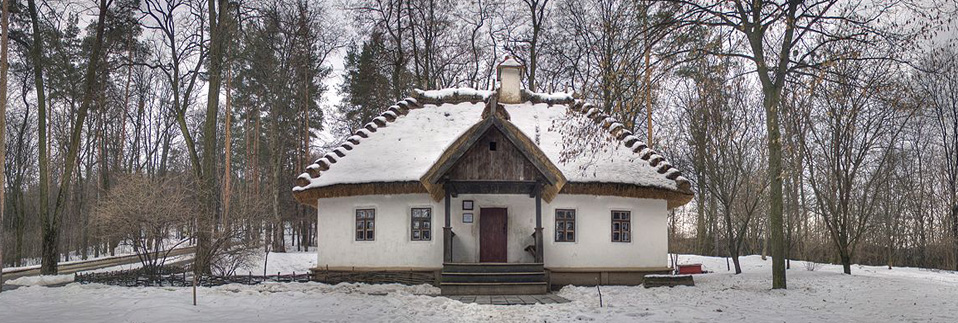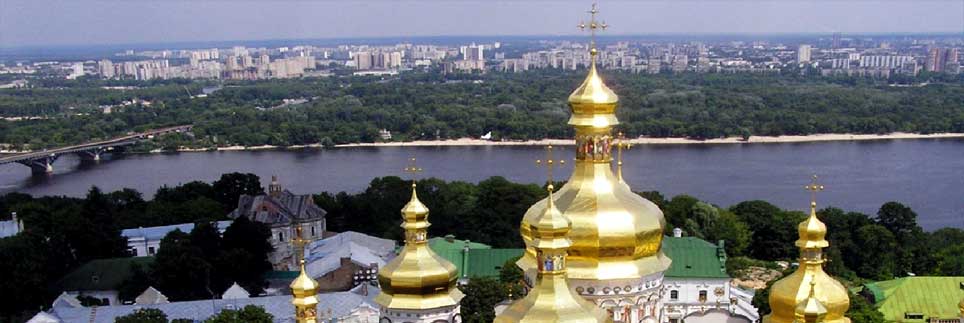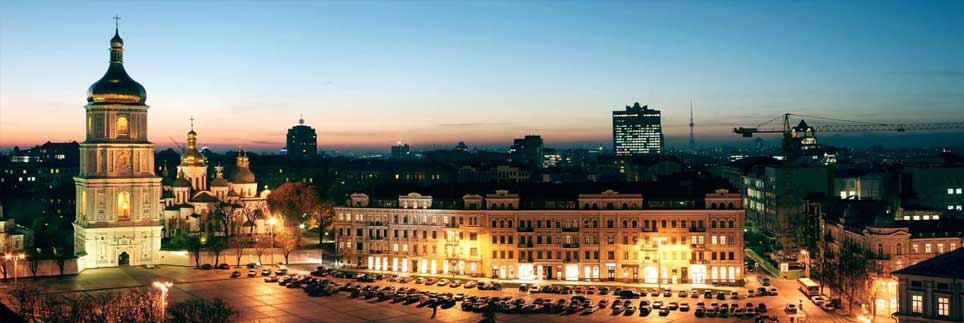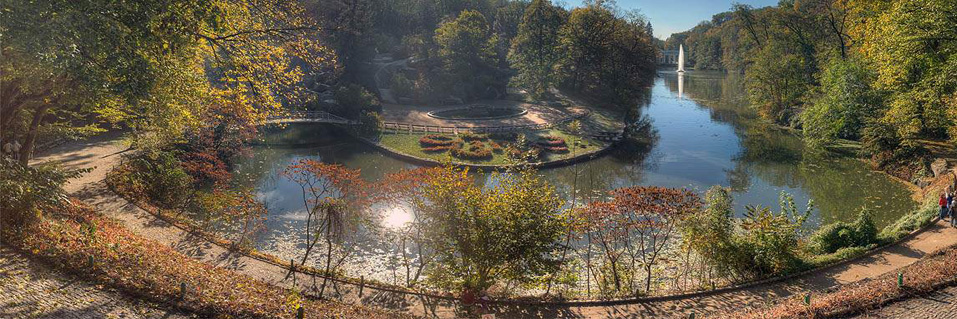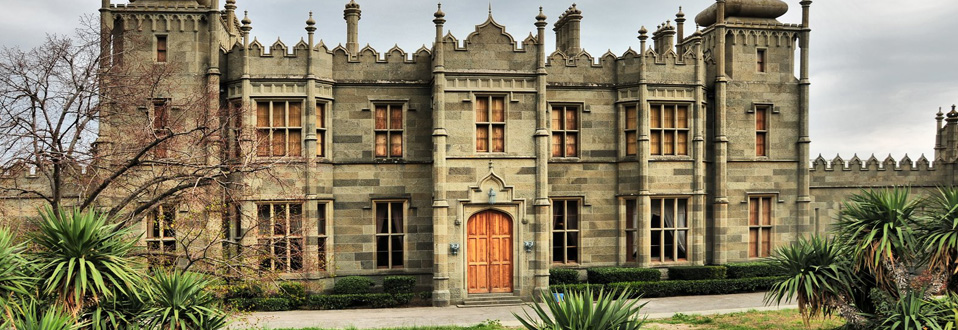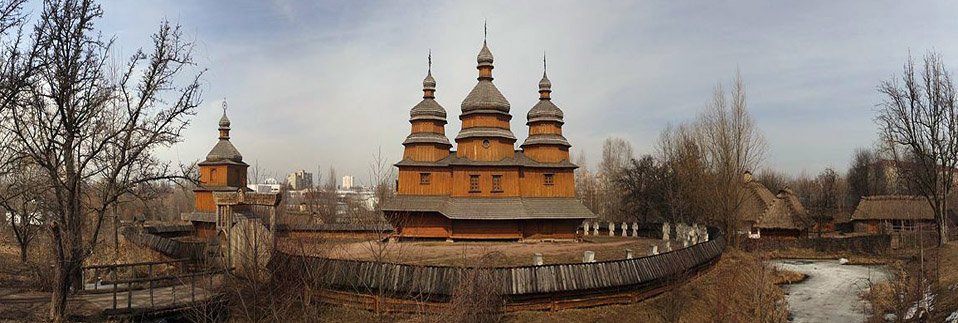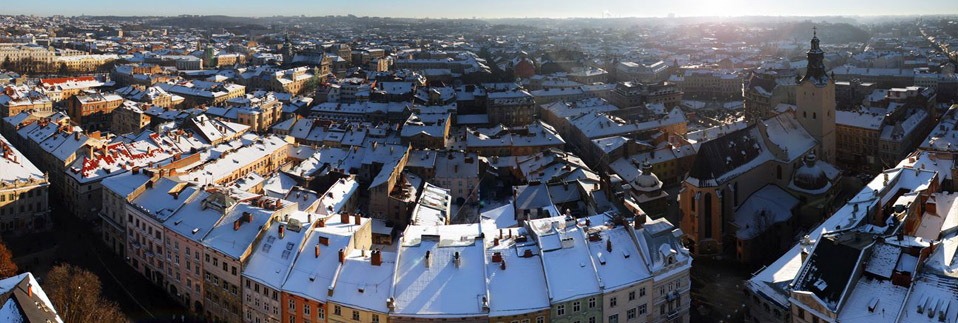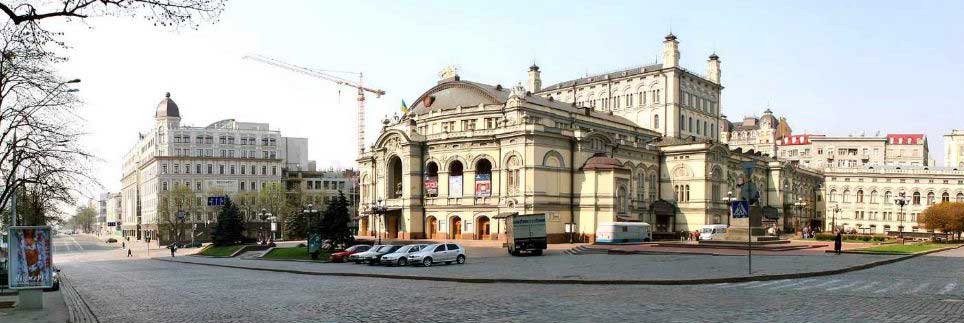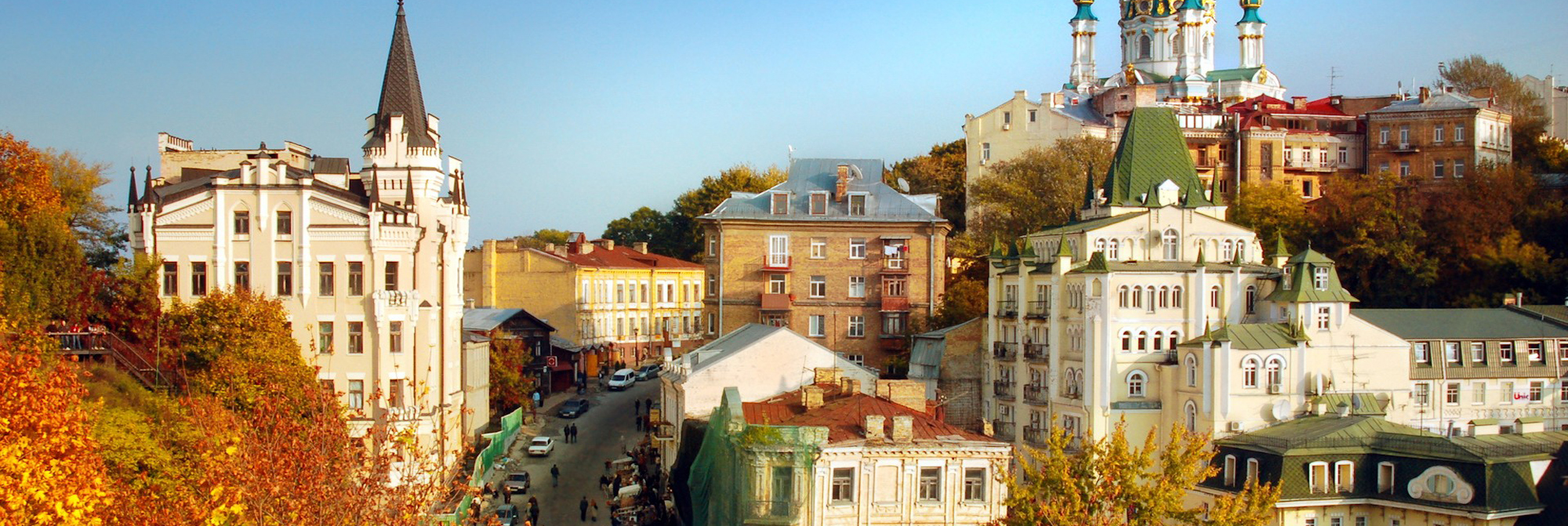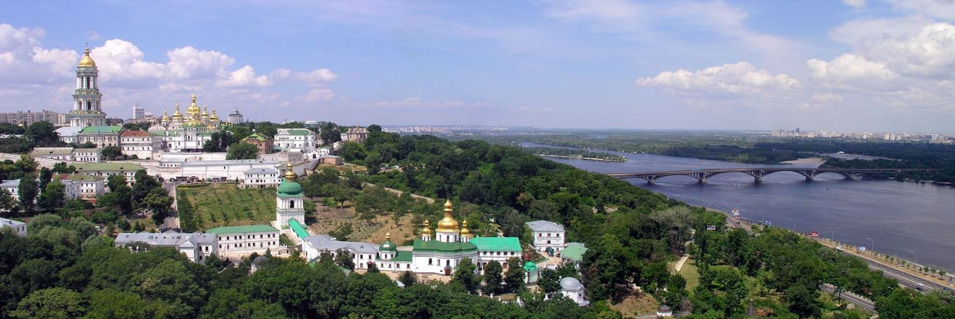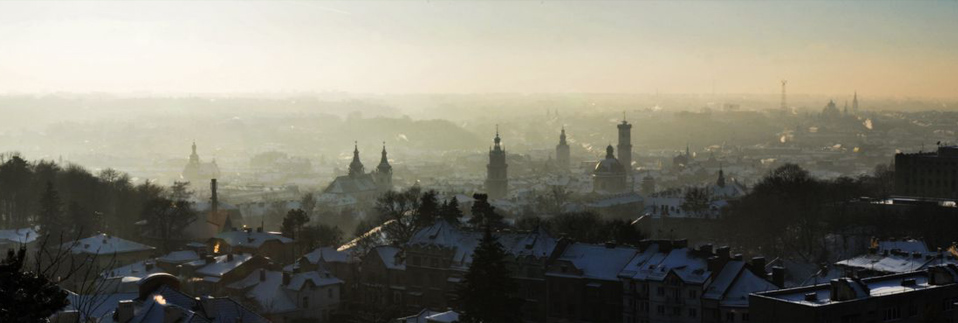Sumy
Sumy
The capital of the region has the population about 300,000. The city is situated on the beautiful banks of the rivers Psel and its tributary Sumka. It was founded in 1652-1655, though people had lived here thousands years before (see the history of the region).
Presumably in the Kievan Rus times there was a town of Lipensk that stopped its existence after the Tartar-Mongol invasions. And only in the first half of the XVII c. the life returned here. Some scientists think that there were two main reasons of organizing a new settlement on the site of the present city. In 1651 Ukrainian Cossacks were defeated by the Poles near Berestechko and the Polish oppression became unbearable for the peasants and the Cossacks and they migrated to the free land close to the Southern borders of Moscow State. At the same Russian government was very interested in strengthening its borders and rendered all assistance in the construction of new outposts. So, such settlements as Sumy had double aim: to be refuge for the fugitives and to become a fortress on the way of the Tartars and Turks. The flow of the runaways didn’t stop till the middle of the XVIII c.
In1656-1658 following the Russian Tsar order voevoda Arseniev built here a fortress in an oak forest. It was surrounded by moat and earth ramparts. It had 8 gates and a secret passage to the river Psel. Living blocks for the civilians were attached to the fortress. Ukrainian settlers actively participated in this construction. It was among them that the legend about the name of the city was born. Three saddle-bags full of gold were found in the oak forest and it was acknowledged as a God Blessing sign. Ukrainian word “suma” that means “bag” was adopted for the town’s name. Local Cossack regiment that had been organized in 1651 had three saddle-bags on its banner. The Cossack chieftain Gerasim Kondratiev, who headed the first Cossack unit to come to the constructing fortress, is considered to be the founder of the city. Since 1781 these tree saddle-bags became the official symbol of Sumy. Another version of the name is connected with the name a small river Suma, a tributary of river Psel.
The town grew rapidly and in 1658 it acquired the status of Sumy regiment Cossack headquarters that lasted for more than 100 years. In the very early years of its existence Sumy turned out to be a bulwark against the Tatar inroads. The siege by the enemies was almost a daily routine. The chronicles say that life was nothing but «wounds, blood, suffering, death and siege». But the town survived even the worst of times and grew in size.
In 1687 and 1689 and then in the 1760-ies Sumy was turned into military stronghold of Russian Army during the anti-Crimean and anti-Turkish. And in the first decade of the XVIII c. it again was in the vortex of political and military events. During the Northern War (1700-1721) Sumy was the headquarters of Russian army in the South. Expecting the approach of the strongest in Europe Swedish army, the fortress in autumn 1708 was preparing for active defense. The threat was so serious that Russian Tsar Peter the Great personally conducted the reinforcement of the fortress and spent here two months. After this war in which part of Ukrainian Cossacks sided the Swedes, the relative independence of the Cossack regiments was limited and after the military reform (1732-1737) these regiments were liquidated. Sumy Cossack regiment became a Hussars’ regiment. In 1718 Sumy became part of Kiev gubernia (administrative region)
The geographical location of Sumy conditioned its quick transformation in the second half of the XVIII c. from a military outpost into important trade fairs centre. The fortress lost itsdefensive role. By the end of the XVIII c. the town became an important centre of trade and handicrafts. Merchants from all over Ukraine, from Russia, from Western Europe, even from distant Asia, flocked to annual fairs that were organized in Sumy four times in a year. The city was famous for the production of soap, candles, leather, jewelry, materials. In 1780 Kharkov vicegerency was organized and Sumy for more than 150 became a “uezd” (district) centre of “Slobozhanschyna”.
The economic prosperity changed the town significantly. The territory of the fortress was turned into the city park. Well known architects were invited to change the general outlook of the city. Some of these newly built houses have been preserved and they are excellent examples of the XVIII c. architectural style of classicism. This construction boom was stopped for some decades after big fires of 1839-1840 that destroyed the best central part of the city. The revival started in 1869 when the biggest in Europe sugar refinery was put in operation. Then some other food processing factories were constructed. And at last a rail road was built in 1877. The city was prospering. Much was done for the city by well known sugar king Ivan Kharitonenko. In his will he wrote: “Love the town of Sumy as I loved it”. A monument to Kharitonenko was erected in 1899 in the central part of the city for the money collected by the citizens
The abolition of serfdom in 1861 helped to spur industrial development. By 1914 Sumy became the most well-kept and organized city of Kharkov gubernia. 50,000 people lived here. Before the WWI there were nearly forty enterprises in the city. Historical catalysis didn’t pass over the city. In 1918-1919 it lost almost all its industry, and than in 1930-ies a number of its outstanding architectural monuments. In 1939 Sumy became the capital of the region. The new status of the city accelerated the upgrowth of its industrial potential. This development was stopped and thrown back by two years of German occupation. The post-war years were characterized by quick reconstruction of industry and creation of new branches of industry.
Today Sumy is the biggest industrial and cultural centre of the region. Almost one half of gross region product is concentrated here. The city produces different pipes, chemicals, hi-tech products, precise instruments, machinery for oil and gas extraction, rolling metal, broadcloth, ceramics, clothes, milk and meat products, sugar, jewellery, beverages, different fodder additions and many others. Foreign companies more and more are interested in the investments into the industrial potential of the region and the city. Since January, 1990, Sumy is a twin town of Zell inGermany.
Sumy attracts visitors by its greenery, clean and well kept streets, professional reconstruction of the architectural monuments of the past that alongside with modern constructions give the city its own charm. The city is surrounded by thick forests; it is one of the ecologically cleanest cities in Ukraine. And there are some really interesting places to visit. Every citizen of Sumy will start to show the guest round the city by taking him to the so-called “stometrovka” (“century”, hundred metres) street that is a heart of the city. Small and exquisite “altanka” (pergola, rotunda) has long become a landmark of Sumy. Your host would tell you a story about a man, who expecting to discover oil, made some digging, didn’t find anything and constructed a small decorative house to hide the traces of his failure.
Any visit of the city usually starts with the tour of the Local Lore Museum. The building of the second half of the XIX c. was constructed for the city administration. During the Germanoccupation most valuable exhibits were lost. To-day the museum possesses unique collection of archaeological items of ancient Slavic and old-Rus periods, rare materials about the history and nature of the region.
House-museum of Chekhov is a place that attracts numerous tourists. Famous Russian writer Anton Chekhov lived in Sumy in 1888-1889. He stayed in the estate of Lintvarev that was located on the Luka river. The writer loved this place and even wanted to settle here. In 1894 he wrote from Italy to his Sumy friends: “The Adriatic Sea is beautiful, but rivers Psel and Luka are much better”.
City residents are proud of the Museum of Art, one of the oldest and most interesting in Ukraine. It was organized in 1920 on the basis of private collections and is located in the building of the former State Bank constructed at the beginning of the XX c. by architect Sholts who can be called the “father of the architectural gems of Sumy”. Its collection consists of the canvases of Italian, Flemish, Dutch, French artists of the XVI-XX cc., as well as Ukrainian icons of the XVIII c, graphics of Shevchenko and many other pieces of art.
Sumy can boast for its temples that have been constructed in different times. The Church of Resurrection is the earliest surviving architectural monument in Sumy. The construction started by the “city-founder” Gerasim Kondratiev and was finished by his son Andrew in 1702. It served a double purpose of a place of worship and of a defensive structure in the north-western part of the fortress. The Church has two altars, a rarity in the Ukrainian churches. It is a two-tiered structure with three cupolas and well decorated interior. It is one of the best examples of Ukrainian architecture that absorbed the best features of wooden architecture. In 1906 a four-tiered bell tower was built near the Church.
St. Transfiguration Cathedral dates almost from the time of the city foundation. In 1776-1788 the wooden construction was replaced by a stone building which later, in 1858 and then in 1882-1892, was reconstructed. In 1882-1885, 56 m high bell tower was added. It was the central Russian Orthodox temple of the city and is one of its architectural gems. This single-domed four-column structure combines elements of the Renaissance, Baroque and Classic styles. The sculptured details of the cornices are masterfully executed; the icon stand is decorated with marble and malachite. Paintings of biblical scenes were made by famous artists Makovsky and Lebedev. 8 pig-iron three-metre high sculptures were cast in local workshop. The English chiming clock still works.
The Church of St. Elias was laid in 1836 but its construction was finished only in 1851 because of the big fires in 1839-1840. It was built on artificial elevation and in Classic style with Eclectic elements. If you are interested in sculptures do not miss a visit of the local cemetery that fortunately has preserved beautiful grave monuments made by famous sculptors Crouasi and Antokolsky. Among the best are the burial vaults of famous dynasties of Kharitonenko and Sukhanovs families. They are located not far from the Church of Peter and Paul. It is a brick structure with cupolas, crucifixion in plan. The original interior ornamentation and several oil paintings have been preserved. It is one of the finest examples of Classic architecture in Eastern Ukraine.
The proud of Sumy and of whole Ukraine is Holy Trinity Church (1901-1914) constructed in classic style with baroque elements. It has resemblance to St. Isaac’s Cathedral in St. Petersburg. It was constructed by local architect Sholts on the money donated by local sugar baron Kharitonenko. Famous Russian artist Nesterov and architect Schusev participated in its interior decoration.
Come and enjoy your stay in Sumy!
Some 50 km to the South and you are in a town full of charm, history and provincial beauty. It was founded by the fugitives from the Right-bank of Ukraine in 1652. The settlement got its name in 1658 and was associated with the beautiful swans (“lebed”) that lived on the lake at a short distance from the town. The town coat of arms depicts a swan on a gold background. This lake is really remarkable and is of great attraction. It is called Shelekhivske. Geologists believe it is one of the oldest lakes on earth — it is estimated to be millions years old which is no younger than such well-known lakes as Baikal, Ladoga, Ontario, Victoria.
In the XVII c. Lebedin was a powerful stronghold with massive defensive walls and 20 towers and was considered to be the best fortified fortress in Ukraine. Here a squadron of Sumy Cossack regiment was quartered. During the Northern war there was a temporary post and headquarters of Peter the Great. In 1780 Lebedin became the centre of “uezd” (district) of Kharkov vicegerency and in a year it got a status of a town. In 1789 a wooden church of Resurrection was constructed. It is the only one building of the XVIII c. that has survived to our days. Certainly it was reconstructed several times. In the second half of the XIX c. a number of temples were constructed. Some of them can be admired to-day. The church of Ascension (1858) with a bell tower is an excellent example of the mixture of classic and baroque style with local colour. Another attraction is St. Nickolas church (1890-ies) represents the so-called “red-brick style” that was spread in Russia at the end of the XIX and the beginning of the XX cc.
It is a combination of the Byzantine style with Renaissance elements. The local masters demonstrated high professionalism in making complicated designs of arches, windows, cornices, ledges and other decorative elements. Unfortunately the church of Protection (second half of the XIX c.) is half destroyed to-day. The style of the typical town architecture of the XIX c. is well traced in the market stalls. Taras Shevchenko, the poet, and Grigory Skovoroda, the philosopher, visited in their time some of the villages in the vicinity of the town.
This small Ukrainian town (population about 36,000) is located only some 35 km from the Russian border and 132 km North-West from Sumy. Unfortunately, for many years in the Soviet era it was buried in oblivion as a tourist attraction in spite of the fact that there was a period when Glukhov was of great historical and political importance – it was the Ukrainian Capital.
The town is located in the basin of the Desna and Seym rivers on the picturesque banks of the tiny river Esman. It is cozy, patriarchal town, with history that dates back from the times of theKievan Rus State. Glukhov was first mentioned in the Ipatievsky Chronicle in 1152 when the town was captured by Polovtsy, though there are archaeological evidences that the town was founded much earlier and in 1992 it celebrated its millennial anniversary. During the XIII-XIV cc. (since 1239) it became the centre of a small principality that belonged to the royal descendants of Prince Vsevolod Sviatoslavich of Chernigov. At that time it was an important economic centre at the crossroad of great trade routes. The ancient plans of the town testify to the fact that Glukhov was once a mighty fortress, surrounded by steep earth walls with bastions, canons and several gates.
At the end of the XIII c. for 100 years it fell under the Tartar-Mongol yoke. A big disaster happened in 1352 – the town died out because of the plague. But Glukhov revived and soon it fell under the rule of Lithuania and Poland but after the Ukrainian war of liberation in the mid-XVII c. and the Pereiaslav Treaty of 1654, Glukhov once again regained its independence. Until the late XVII c. it was the centre of cannon and gunpowder production.
A very special stage in the history of this ancient town is connected with the events of the early XVII c. In 1708, after the Ukrainian Hetman Ivan Mazepa sided with Charles XII of Sweden in the Great Northern War, the town of Baturin, the seat of Hetmans, was reduced to rubble by the Russian troops under the command of Alexandre Menshikov. The Russian Tsar Peter the Great, furious at this outcome, subsequently ordered an official ceremony of “damnation and execution of Mazepa the traitor”. Mazepa was symbolically executed and anathematized opposite St. Nickolas church. For this ceremony a stuffed figure of Mazepa was hanged, all decorations that Mazepa had been awarded with were torn from his suite and for a long time the stuffed figure of Ukrainian Hetman was swinging in the centre of the town. Peter the Great decided to move the Hetman’s capital to Glukhov - closer to Russian borders. The Tsar came to Glukhov for the election of the new Hetman of Ukraine. Ivan Skoropadsky, a colonel from Starodub, was elected or better to say appointed Hetman of Ukraine. That is how in the XVIII c., less than 300 ago, in this small Ukrainian town sat the former Capital of Ukraine.
In the second half of the XVIII c. part of Ukraine that was annexed to Russia was ruled alternatively by the Hetmanate and Malorossiyskaia (“Little Russian”, “Little Russia” was the official name of Ukraine) Collegium established in 1722. Both were continually being abolished and reinstated, and Ukraine steadily lost its autonomy. In 1750 the Cossacks leaders, obeying the will of Empress Elizabeth’s government, elected Kiril (Cyril) Razumovsky as Hetman. Razumovsky became the last Hetman of Ukraine and his election did nothing to promote the cause of Ukrainian autonomy. This Hetman was nothing but typical courtier and the Hetmanate was doomed to history. But for several decades Glukhov became not only an administrative capital of Hetmanate, but also an important cultural centre of Ukraine. In 1730 an amateur theatre began staging performances and under Hetman’s patronage developed into professional company. In 1738 a music school was created, it trained singers for the court choir in St. Petersburg. Special scouts were sent to raid Ukrainian villages hunting talented singers. Among the students of Glukhov music school were famous composers Maxim Berezovsky and Dmitry Bortniansky. It is said that famous poet and philosopher Grigory Skovoroda also took classes here.
Tragic fate pursued the town. In 1748 a big fire destroyed almost entire town, and it was then when famous wooden Trinity church that was regarded as the main place of worship, burneddown. After this fire Hetman Razumovsky decided to move its capital to an old place – to Baturin. Nevertheless, for the coming 30 years Glukhov was under intensive construction, it was the first town in Ukraine where the principle of centralized planning was implemented. In 1786 the Little Russian Collegium was abolished and Glukhov lost its position and significance and gradually turned into a typical provincial town. Only in the middle of the XIX c. the life became more vibrant due to the efforts of Ivan Tereschenko who started here sugar production and grain trade.
The town suffered much during WWII, but nevertheless, Glukhov has managed to preserve some buildings and atmosphere of the past. The town and its surroundings boast several little known, but very interesting landmarks and architectural ensembles. Among the architectural attractions one can see first of all the remains of the Cossack fortress, including the Kiev Gate made of stone and the Moscow Gate, Triumphal Gate (1785) in the classic style with baroque elements. In the centre of the town there is the Council Square where one can see Saint Nicholas Church – the oldest construction in the town. It dates back to the XVII c. (1686-1695) and for more than 100 years it was an architectural centre of the town. It was here that the Cossacks elected Hetmans Danilo Apostop (1727) and Kiril Razumovsky (1750). In spite of later reconstructions in the XIX c. and recent restoration, when in 1991 it was returned to the parish, St. Nicholas church is an outstanding monument of the Cossack Renaissance. The three storeyed building of former Little Russian Collegium, even after some reconstruction, still have some baroque and classic elements and reminds the architectural style of St. Petersburg. Among other architectural monuments one can see the Church of the Transfiguration (1765) that was constructed on the place of the burnt one in 1748, and the church of Ascension, built in the XVIII c.
Unfortunately frequent fires destroyed the former Hetmans palaces and wooden houses of the Cossack elite. The Cathedral of Three Anastasias (1884-1893) was constructed for the money of one of the most famous sugar barons and patron of arts Michael Tereschenko who was born in Glukhov. It is a replica of St. Vladimir’s Cathedral in Kiev, very beautiful icon-stand made of white Italian marble was done in stylized Byzantine and ancient Russian traditions. The walls were painted by brothers Svedomsky. The Coat of Arms of Glukhov is the Water pumping station constructed at the beginning of the XIX c. The tower is itself a piece of interesting architecture – it was constructed in a shape of a mace and stands on the highest point of the town. To-day the central part of the town is a state cultural and historic preserve and every year more and more tourists come here.
On the way to Glukhov one can make a stop in Putivl, a small town on the Seim river, 90 km north-west from Sumy. The archaeologists found here the settlements dating from the IV c. B.C. The town is well known because of its association with renowned enigmatic masterpiece of medieval epic “Tale of Igor’s Host” (“Slovo o polku Igoreve”, in some translations “Tale of Igor’s Campaign”, “The Lay of Igor’s Host”). One part of the poem describes vividly and poignantly, the lament of Igor’s wife, Yaroslavna, who, standing on the high defensive wall of Putivl fortress, is grieving the fate of her husband and son. This part of the Tale is considered to be the most expressive and poetically perfect. The monument to Yaroslavna graces one of the central places of Putivl. The opera “Prince Igor” by great Russian composer Alexandre Borodin is based on this poem.
Putivl was first mentioned in the Hypatian Chronicle under the year of 1146. It was the seat of the Olgovichi, the Novgorod-Seversky Princes. It was the time of disunity of Kievan RusState when, torn by internecine clashes, the country could not withstand the devastating attacks of Polovtsy. The Tale describes real facts. In 1185 Prince Igor (grandson of Chernigov Prince Oleg) started from Novgorod-Seversky his military campaign against Polovtsy (they were cattle raisers and warriors). He was accompanied by his brother Vsevolod and in Putivl his son Vladimir joined them. On the way to the battle field (in to-day’s Lugansk region) they saw a solar eclipse and everybody warned Igor of this omen. But Igor said: "Brothers and druzhina (military unit)! Nobody knows God's mystery, and God is the creator of mystery, as well as of all His world; but we shall find out in time whether God means our good or our evil." In two days Igor sustained a crushing defeat; he was wounded and taken prisoner. The courage, pride and valour of the Russian prince delighted the Polovtsy’s chieftain Konchak, he even proposed Igor to stay forever with him. According to the Chronicle Prince Igor, early in his captivity, became deeply troubled by feelings of guilt for killing people in the internecine wars and also he felt that it would be dishonorable for him to try to escape. But news about the new military campaigns prepared in Kiev made him to change his mind. He ran away from the Polovtsy camp and after return to Putivl he appealed to stop the clashes and called for unity of Kievan Rus Land.
The whole Tale is permeated with the ideas of patriotism and personal responsibility of everyone for the destiny of his country. And at the same time it is full of very interesting descriptive details and human emotions.
In 1356 Putivl became the district centre of the Lithuanian state. Later, in 1500, Putivl was ceded to Moscow Principality. In the second half of the XVI c it was one of the 16 towns that made the defense front line along the Southern steppe border of Moscow State. After the truce talks with Turkey in 1681 and Poland in 1686 the military importance of the town was lost but its economic life continued to develop. In the mid-XVII c. Putivl established trading relations with the Near East, the Balkans and Southern Europe. Situated on the trade way that connected Ukraine with Russia it became an important economic and trade centre in the South of Russia in the XVII-XVIII cc.
Putivl has been lucky to preserve some remarkable ancient architectural monuments. Molchansky (“Silent”) monastery was built in the XVI-XIX cc. on a hill above the Seim river. The complex of this stone fortress-monastery includes the Nativity of the Mother of God Cathedral (1575-1785), over gate bell tower (1602-1604), Refectory with tower XVII c, walls and towers. In the early XX c. the cellars of the cathedral were used as storehouses for food and gunpowder.
Our Saviour Transfiguration Cathedral was constructed in 1617-1693 in the best traditions of old-Russian architecture. It has five onion-shaped cupolas, one-storey church porch surrounds the building from tree sides, and one altar chapel with cupola is located in its northern part. Among other architectural attractions are: the Church of the Nativity of St. John the Baptist, Evaluation of the Cross above-the-gate tower church (1707) and St. Nickolas Cossack church constructed in the best Ukrainian traditions in 1733-1737 for the donations of citizens and the bell tower of 1770.
A very important notable event of the history of Great Patriotic war 1941-1945 is connected with Putivl. At the beginning of war it became a centre of the Ukrainian resistance movement that was headed by Kovpak. Some information about Sidor Kovpak (1887-1967).He was born in a poor peasant family, worked at a plant and in 1914 he was called up for military service during WWI.Emperor Nicholas II of Russia personally awarded him with two Crosses of St. George (an award for special military heroism). After the Revolution of 1917 he joined the All-Russian Communist Party (Bolsheviks) and fought for the Red Army partisan units against the German forces and Denikin's White Army in 1918-1919. In the 1930-ies Kovpak occupied different civil posts and in 1937-1941 he headed the town government in Putivl.
In autumn of 1941 he managed to bring together local underground groups with small army units that broke through the German encirclement of the Soviet forces East of Kyiv. The forests between Putivl and Glukhov became the base of this detachment. Under the command of Kovpak and commissar Rudnev in 1942-1943 it grew in the biggest partisan unit on the occupied territory of the Soviet Union. Real guerrilla war was waged against the Germans in Sumy, Kiev, Kursk, Briansk and other regions. This partisan unit also fought against nationalist Ukrainian Insurgent Army.Then, in May 1943, Kovpak was sent on a long raid from Putyvl across Volyn to the Carpathian Mountains. With severe battles, spreading panic, destroying the railroads, river fords and bridges, advancing the regular Red Army troops, inflicting heavy casualties on the Germans, the unit covered 18,000 km and reached Romanian border.
Kovpak became a living legend in the Soviet Union. He was awarded Hero of the Soviet Union title twice (1942, 1944) and in 1943 was promoted to the rank of lieutenant-general. After the end of the Great Patriotic War Sidor Kovpak held key positions in the leadership of Soviet Ukraine. The monuments to Rudnev (1961) and to Kovpak (1971) were erected on Putivl.
A museum of Local Lore and History, burial mounds dating from the VII-VIII cc., a XIX c. china factory (chinaware produced at the factory was well known within and outside Ukraine for its high quality) are among the sights regularly visited by tourists in Putivl.
This ancient town is at the distance of 103 km to the West from Sumy. It population to-day is about 50,000. The town lies along the Sula river. For the first time it was mentioned under the name of “Romen” in the testament “Precept” (“Homily”) of Kiev Prince Vladimir Monomakh. At that time this fortress was part of Pereiaslav Principality of Kievan Rus State. Some scientists presume that the town is much older. Not far from the present day town the archaeologists discovered a settlement of an Eastern Slavic tribe, dating from the VIII c. It could be founded some time after 988, when Kiev Great Prince Vladimir (the Baptizer) had people relocated to "establish fortified towns along the rivers Desna, Ustriyi, Trubisheva and Sula." In the XIV-XVII cc. Romny, keeping its status of a border town, was part of the Lithuanian Principality, than it was given to Moscow State in 1632, than to Rech Pospolita, and finally in 1654 it became part of Russia. In 1644 it was given the Magdeburg Law Right. In the national liberation war of the XVII c., with Bogdan Khmelnitsky as commander-in-chief, Romny played a role of headquartres of some Cossack regiments. Later, in 1708, Ivan Mazepa and the Swedish King Charles XII captured the town and established their headquarters in Romny. Hetman Mazepa was traditionally looked upon as a traitor for siding with the Swedish king against the Russian Emperor Peter the Great, but more recent historical studies suggest that he was rather an Ukrainian patriot who wanted to gain independence for Ukraine through alliance with the Swedes. Hetman Ivan Mazepa spent the winter of 1708 in the city with his ally King Charles XII of Sweden before moving against Peter the Great of Russia in the fateful Battle of Poltava in 1709. After the defeat of the Swedish army, the Russian troops stormed the town, massacred the inhabitants and burned the town down. But the town did not die — it was revived and in the XIX c. and early XX c. centuries it was a place of some cultural activity. Due to its very convenient geographical location it became in the XVII-XIX cc. a centre of big trade fairs. In 1781 Romny became a “uezd” (district) centre of Chernigov area, than in 1796 of - Little Russia (the official name of Ukraine in the XVII-XIX cc.) and in 1802 “uezd” centre of Poltava area. Constructed in the XVIII c. buildings, mainly the temples make the architectural fame of the town to-day. The Cathedral of the Holy Spirit was constructed in 1738-1747 on the highest point of the town close to the remnants of an ancient settlement. In the XIX c. a near-by Bell tower (1751-1780) was transformed into the church of St. Basil, it still functions. But the main attraction of the town is the church of Ascension and its bell tower (1797). Ukraine's national bard, Taras Shevchenko, for a time resided in this city. In 1918, in remembrance of that, Romny was the first city in Ukraine to erect a monument to him. For the time of its construction the monument looks rather unusual, very human and informal, but it was made by the famous Ukrainian sculptor Ivan Kavaleridze, who was always ahead of his time. Kavaleridze was born in Romny and this monument was his present to his native town. The last h ad ataman (chieftain) of the Zaporozhian Sech, Petr Kalnyshevsky, was born in a village near the city. The 18th century artist Ivan Stetsenko lived there. The 20th century writer Boris Antonenko-Davydovych was born there. Rather unusual monument appeared in Romny in 2000 on the initiative of the town mayor - monument to a Pig. This animal was and continues to be of big importance for Ukrainian people. In the years of the Tartar invasions, when for almost three centuries these nomadic people plundered these lands, the pigs saved the population from hunger - the Muslim Tartars didn’t eat the pork and they didn’t kill pigs and these animals helped the local population to survive. Pork and especially the pork-fat are widely used in the Ukrainian food. There are many jokes about the predilection of Ukrainians for the pork-fat that often is referred to as a “national symbol”. More about the history of Romny one can find in the Local Lore museum. A huge granite boulder in front of the building was brought here by the glacier 150-200 thousand years ago. Romny to-day is well known not only in the neighbouring regions for its milk factory and bread-backing plant. There is also a plant of automatic telephone stations, shoe and clothing manufacturing factories. An agricultural college and a medical school are also located here. On the way to Romny one can make a short stop in Kuleshovka to see the place where in 1839, for the first time on the territory of the former USSR, the remnants of the Mammoth’s skeleton were found. The discovered bones were 150-200 thousand years old; they were transported to Kharkov museum. A monument to this prehistoric animal was erected in the village in 1841. Russian-Polish border passed here in the XVII c.


